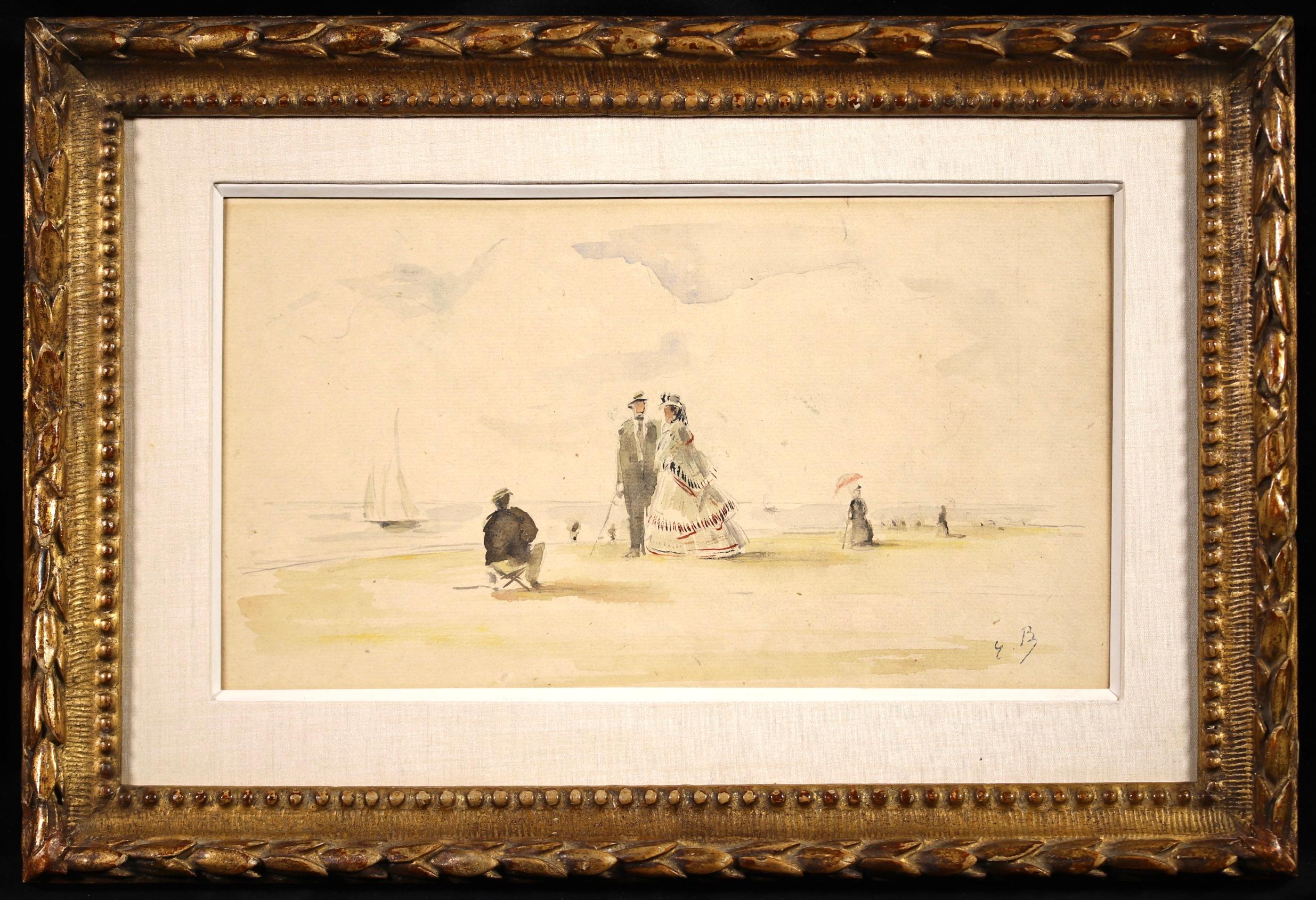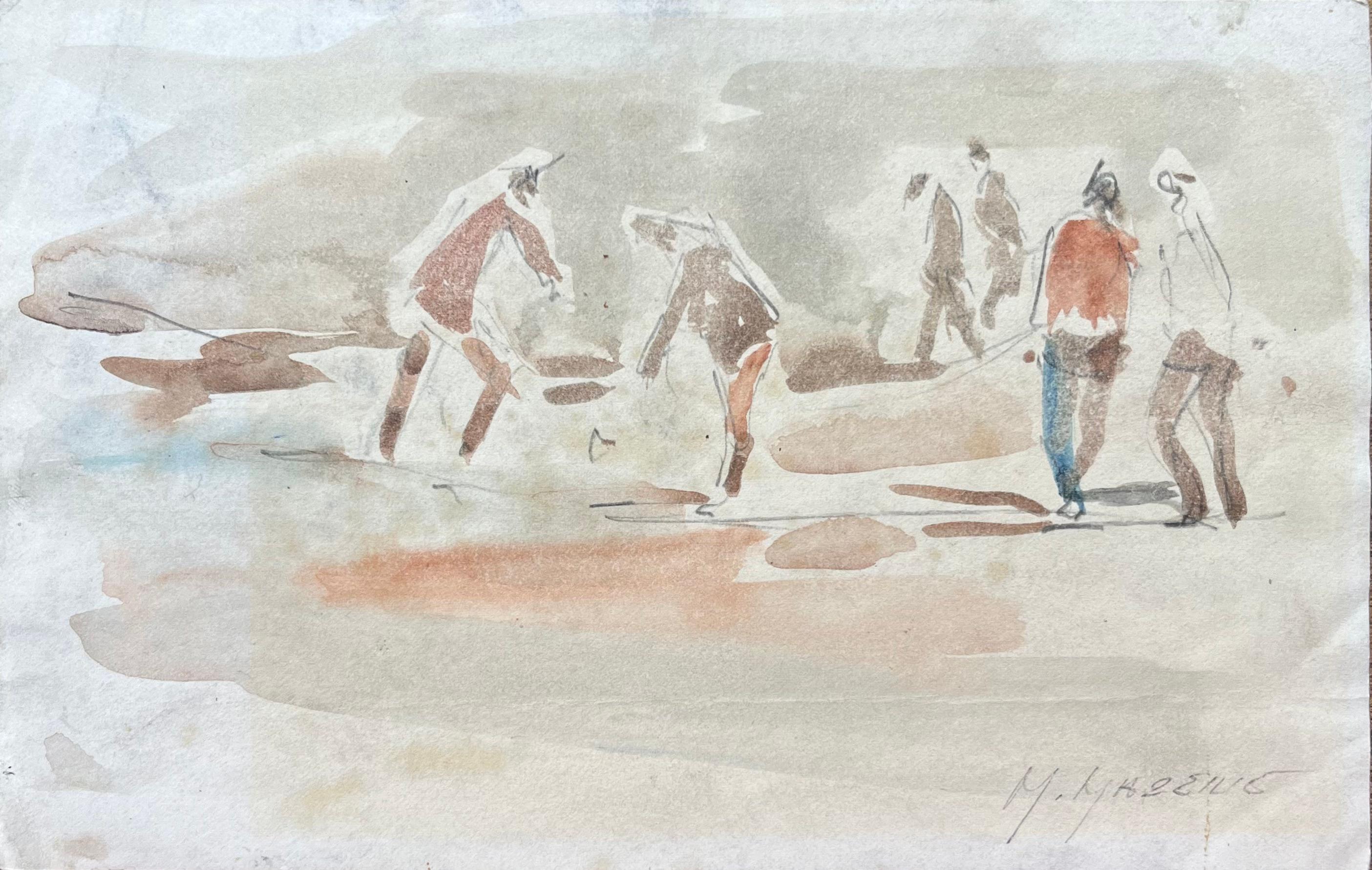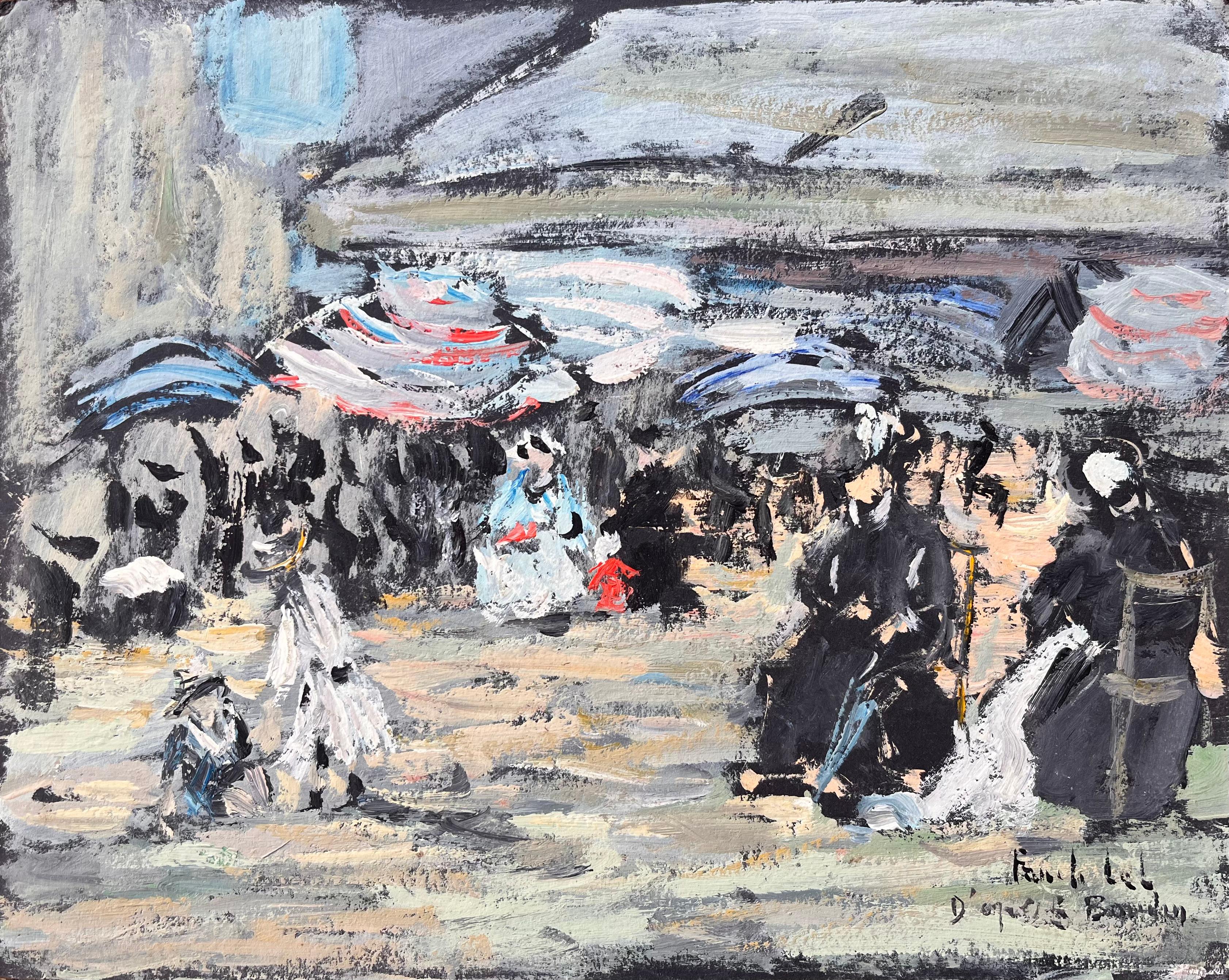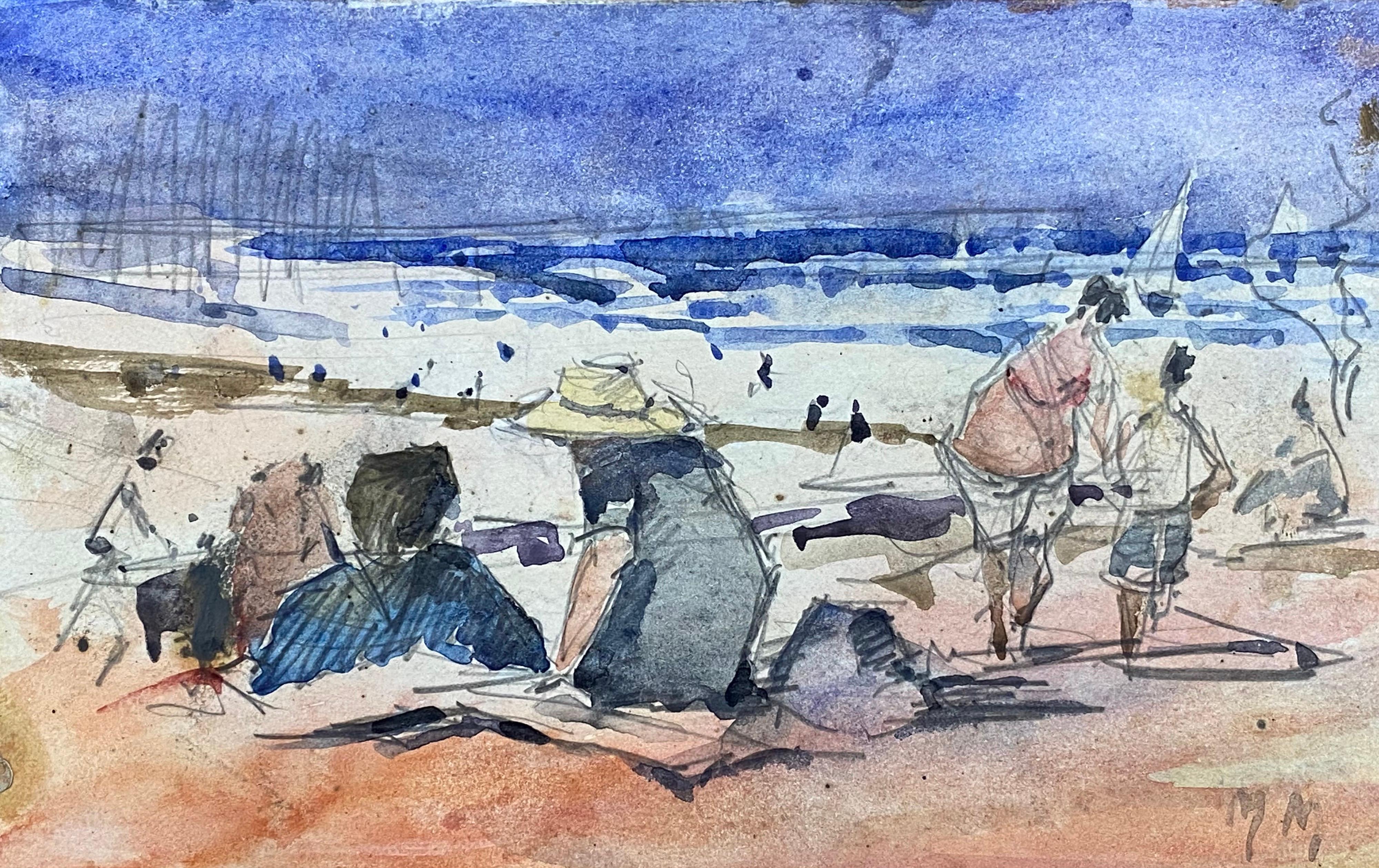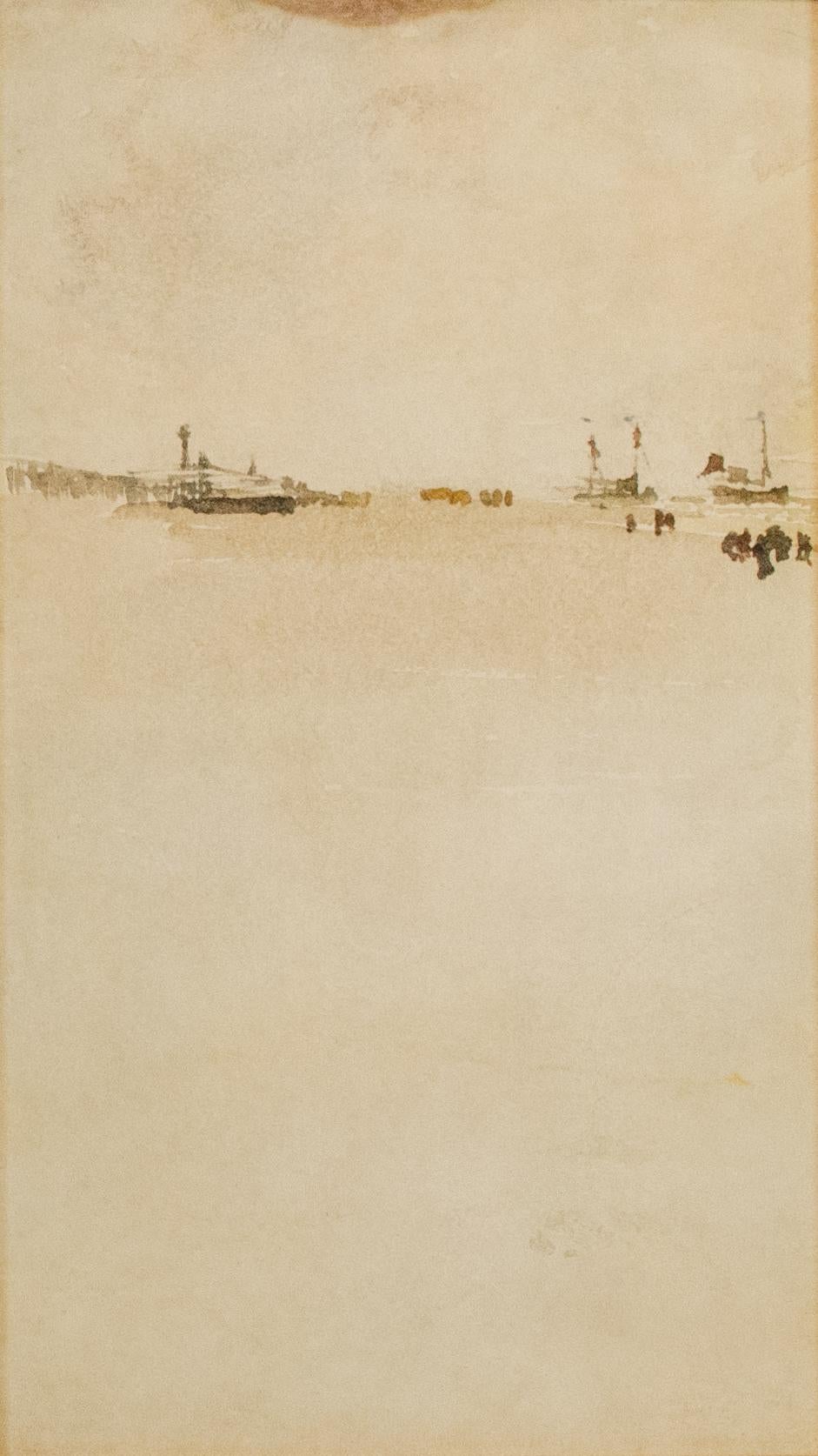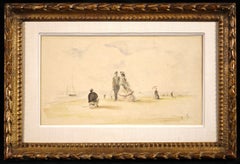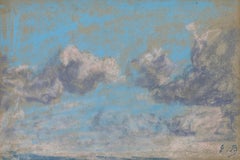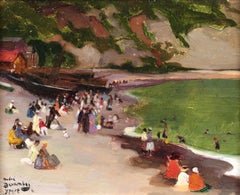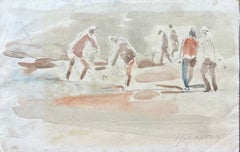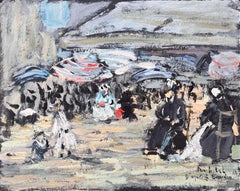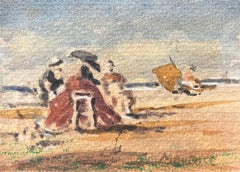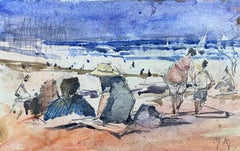Items Similar to Crinolones sur la Plage - Impressionist Figurative Watercolor by Eugene Boudin
Want more images or videos?
Request additional images or videos from the seller
1 of 14
Eugène Louis BoudinCrinolones sur la Plage - Impressionist Figurative Watercolor by Eugene Boudin1867
1867
$25,157.52
£18,335
€21,595.37
CA$34,605.43
A$38,555.59
CHF 20,334.35
MX$467,424.26
NOK 258,682.23
SEK 240,978.88
DKK 161,297.46
About the Item
Signed and dated watercolour and pencil on paper by impressionist painter Eugene Boudin. The work depicts elegantly dressed people enjoying a day on the beach. Some women are resting under parasols.
Signature:
Signed lower left with cachet and dated 1867 lower right
Dimensions:
Framed: 14.5"x17.5"
Unframed: 5"x8"
Provenance:
Robert Noortman Gallery - London (c. 1990) - Inventory number 754 - labels verso
The son of a mariner, Eugene Boudin initially considered becoming a marine pilot. However, a year after his family settled in Le Havre, in 1835, he began work as an apprentice at a printing/publishing house, then in a stationery firm, where he stayed until he was 18 before setting himself up in the same business. Passionate about drawing and painting, he was given encouragement and advice by the painters Millet, Isabey, Couture, Troyon and Masurier, whose pictures he exhibited in his shop windows. In 1846 he left his shop, devoting himself fully to art. Several changes of fortune then followed. First, in 1847, he moved to Paris, where he spent many hours in the Louvre. Secondly, the desire to escape the upheavals of the 1848 Revolution forced him to travel throughout northern France and Belgium, giving him the opportunity to study the Old Flemish masters. In 1851, Le Havre Municipal Council awarded him a three-year scholarship, which he spent in Paris and, primarily, in Honfleur. Many years of patient effort, application and hard work ensued, documented in numerous sketches and drawings conscientiously depicting his travels and his thoughts. From the outset, Boudin's work is marked by his desire to paint the actual scene before his eyes, and not to impose imaginative elements; thus, he attempts to translate the ever-changing spectacle of the skies and clouds racing over the sea directly into pastel, watercolour or oil. In 1855, he made his first trip to Brittany, to the Finistère area, where he was often to return during his lifetime. His subjects there included the indoor and outdoor markets, festivals, people leaving mass and the Breton pardons or religious festivals, as well as the wild, rocky coasts, characterized by far darker hues and more threatening skies than the coastline of his native Normandy. In 1858, he made the acquaintance of Claude Monet, who was staying at Le Havre. Boudin gave Monet a taste for painting en plein air, and continued to be associated with him for the rest of his life. In 1859, he met Courbet and Baudelaire, the latter of whom was the first to acknowledge his talent, in Salon of 1859. Around 1860, Boudin decided to settle permanently in Paris. He worked for Troyon, preparing the skies in his compositions, and was acquainted with Corot, Daubigny and later Jongkind, whom he particularly admired. During the Franco-Prussian War of 1870-1871 he fled to Belgium, where he produced many fine paintings, notably in Antwerp in 1871 and 1872. On his return to Trouville in September 1871, his works sold readily. He worked until his strength was exhausted, painting his last picture in Beaulieu in 1898. In May, he was taken back to Paris, then to Deauville, where he died by the sea on 8 August 1898.
Eugene Boudin first exhibited in Paris in 1857, at the Concert Musard, at the age of 35, with Alexandre Dumas purchasing two works. In 1859, he made his Salon debut, going on to exhibit regularly there until 1897. In 1874, he took part with Nadar in the first Impressionist Exhibition in Paris, and his reputation was firmly established from then on. From 1881, the art dealer Durand-Ruel bought the majority of his works and regularly organised exhibitions. In addition to the pictures that Boudin sent to the Salons, his works were included in many other exhibitions, of which only those organised by Durand-Ruel are cited here - 1883: 150 paintings; 1889: 89 paintings; 1891: 33 paintings, 35 pastels, 190 drawings; 1898 (in New York): 49 paintings; 1903 (New York): 39 paintings; 1923: 66 paintings; 1927: 44 paintings; 1929 (New York): 33 paintings; 1933 (New York): 30 paintings; 1936: 20 paintings. Following his death, a retrospective exhibition of his works was organised at the Paris École des Beaux-Arts in 1899, which included 364 paintings, 73 pastels and 20 watercolours. After almost a century without a retrospective exhibition of his work, the town of Honfleur paid a great tribute to him in 1992. Boudin had not seen many such acknowledgements during his life. In 1881, he was awarded, for the first time, a third-class medal at the Salon, subsequently receiving a gold medal at the 1889 Exposition Universelle. He was finally made a Chevalier of the Légion d'Honneur in October 1892.
From 1862, and on the advice of Isabey, who had been Boudin's tutor (though other sources state it was at Baudelaire's instigation) he painted elegant women on the fashionable beaches, especially Trouville, which could be reached by rail. These motley crowds were often depicted by touches of colour which, starting from vague shapes, could develop into the clear form of the fashionable lady of the Second Empire or the dandy. With regard to his 'high society' models, in contrast to Millet's social preoccupations or Courbet's political concerns, it is intriguing to read Boudin's contemporary opinion of the artist's role in society. In 1861, he wrote to a friend: 'Peasants have their painters. That's good. But, between you and me, these middle-class people who stroll along the jetty into the sunset, are they not also entitled to be captured on canvas, to be led towards the light? Between ourselves, they often work extremely hard, these people who step out from their offices and their studies. If among them there are a few parasites, are there not also people who do their job properly?' It is obvious that the question bothers him. Even if he only formulates it in terms of certain people's right to be used as models by the artist, the question signals a deeper concern with the place of art and the artist in bourgeois society, which tends to spurn artists as innovators, and thus implicitly as revolutionaries. In common with many artists of the 19th and 20th centuries, Boudin resolves the matter by separating the aesthetic from the moral. He no longer considers the social status of his models, but concentrates solely on their external appearance. Thus, in another passage he concludes: 'One experiences a certain shame when painting idle laziness. It is fortunate that the Creator has scattered a little of his splendid and warming light everywhere; it is the world that is enveloped by this light that we painters reproduce'. The key term here for Boudin is 'light' - it is apparent that the actual objects he paints hold little interest for him in themselves; far more important is the beautiful play of light on those objects.
Throughout his life, as soon as spring arrived, Boudin could be found setting up his easel on the open coast, or on quaysides, painting seascapes with three-masters and fishing boats. In 1874, he stayed for a long spell in Bordeaux. He continued to be prolific, travelling almost every year to the beaches of northern France, returning to Trouville, to the banks of the River Touques, where he liked to paint the washerwomen, to Honfleur, and to Le Havre. Although he twice travelled to Villefranche, in 1882 and 1887, it was not until 1890 that he painted extensively there, staying in the Midi region each winter for longer and longer periods, and moving on as far as Venice in 1892 and 1895. The period during which he painted the cliffs of Étretat on the Normandy coast with increasingly thick brushstrokes (perhaps under Monet's influence), was followed by a period of grey and mother-of-pearl tonalities.
Eugene Boudin's work is not only important in its own right and for what it reveals about the artist, it is also highly significant (despite Boudin's own sense of modesty) for the historical part it plays in the development of painting - in particular, the beginnings of 'open-airism' and the birth of Impressionism. The Impressionists recognised Boudin as one of their forerunners by inviting him to join their group in 1875, and Monet paid him no small tribute by stating that if he had become a painter, he owed it to Boudin. It is also useful to recall a few dates to highlight Boudin's historical importance, which is inseparable from the roughly similar role played by Jongkind, who, although very different in character, showed great kinship with Boudin in painting sur le motif. Constable died in 1837, Bonington's short life ran from 1801 to 1828 and Turner died in 1851. Delacroix, who took his place among the forerunners of Impressionism only by virtue of the profound influence English landscape artists exerted on his work, died in 1863, while there is no doubt that Corot and the painters of the Barbizon School expressed a new feeling for nature. All these artists began to work outside, but all the works they prepared or sketched in the open air 'go back through the studio again', in Corot's words. Still a long way from recognising and trying to convey the essential fluidity of nature, which the Impressionists made into a dogma, these earlier artists therefore had no conception that a painting did not have to be ‘composed’ or ‘finished’ - a task that could only be completed in the calm surroundings of the studio. Even so, in their initial studies, their more direct contact with nature and especially with real sunlight, diffuse and no longer governed by the 'lighting' of a studio, helps lighten their palette and bathe the whole canvas in light. These artists are thus led to think in advance about the actual nature of light and its unexplored pictorial possibilities. Courbet painted Young Women on the Banks of the Seine in 1856, Manet painted Concert in the Tuileries Gardens around 1860, The Picnic ( Le Déjeuner sur l'Herbe) in 1863, Races at Longchamp, Paris in 1864, Degas painted Gentlemen's Race, Before the Start in 1862. The phrase 'before the start' is revealing. It no longer indicates a precise moment in the past, but all the sensations that characterise a moment of real time that has been experienced, almost an 'impression'. These works are still composed according to a set formula of combination; in other words, the landscape is painted outdoors and the figures are added in the studio, the people seem to be posed on the backgrounds and are still painted using the technique of local colour. The landscape, which is separate from the figures, and which is recomposed in accordance with classical antecedents, remains constrained, The Picnic ( Le Déjeuner sur l'Herbe) being a very typical example of this. It was not until 1867 that Monet painted his Women in the Garden fully en plein air, with both landscape and figures observed outside. It would not be long before new scientific discoveries on the composition of light and Chevreul's pioneering work on colour theory would fundementally change artists' attitude to nature and bring Impressionism to its peak.
However, in advance of Impressionism, yet with no inkling of their historical significance, Jongkind and Boudin had already resolved in practice many of the movement's abiding concerns - namely, how to grasp the colour and flavour of a fleeting instant, how to capture the transparency of the atmosphere and its distance, and how to integrate figures naturally into the landscape. This they achieved simply by painting exclusively outdoors, and by painting only what they really observed outdoors, as they saw it. The Le Havre painter Charles Lhullier, who knew Boudin and Jongkind and painted with them on the Normandy coasts, gaining from them an understanding of how colours interrelate in and by means of the precision and unity of the light, was able to pass on this sense of light, so typical of the French School from the time of Poussin and Claude Lorraine, to his students at the École des Beaux-Arts in Le Havre, students such as Dufy, Friesz and Braque. This sense of the accuracy and unity of light, inherited from Boudin, would also go on to influence Fauvism and so to differentiate it fundamentally from the work of the central European Expressionists, who employed unnatural colours principally for their shock value.
Museum and Gallery Holdings:
Agen: Russian Corvette in the Eure Docks
Alençon: Rocks of Antibes (1893); Cattle in the Marsh (acquired in 1894)
Algiers: Port of Trouville
Baltimore (Walters AM)
Bayonne (Mus. Bonnat): Beach; Boat at Low Tide; Low Tide at Étaples (1890, gift of Baron Rothschild)
Boulogne-sur-Mer: Port of Le Havre; Port of Le Havre; Environs of Trouville; Sunset; Étaples; Regatta; Touques Old Port; Ruins of Larsay Castle; Juan-les-Pins
Caen: Tourgeville Beach (1893); Cattle in a Meadow (1874, gift of M. Jacquette)
Cambrai: Trouville Port at Low Tide
Dallas (MA): The Quay at Antwerp (1874, oil on panel)
Dieppe: Port of Dieppe (sketch, gift of M. G. Cahen)
Dijon: Port of Trouville; Port of Honfleur; Cow in Meadow
Edinburgh (Nat. Gal. of Scotland): The Port of Bordeaux (1874, oil on canvas)
Honfleur: Dusk (gift of M. Alexandre Dubourg); Portrait of the Artist's Father; Still-life (Fish); Still-life (Fish); Still-life (Game); Still-life (Leg of Lamb); Study of Horse; On the Beach; On the Beach (Portrait); On the Beach (Family Meal); Still-life (Game); Mme Pécrus in her Garden; Village of Fesvaques; Study in Antwerp; Landscape with Figures; View of Trouville; View of Trouville; Landscape; Berck Fisherwoman; Normandy Woman; Portrait of a Young Girl; Portrait; Flemish School Copy (Game); Flemish School Copy (Game); The Embarkation for Cythera (copy, after Boucher); Woman with Goat (after Boucher)
Johannesburg: Regatta; Jetty at Trouville; Port of Trouville (gift of Otto Beit)
Le Havre: Still-life; Pardon of Ste-Anne-la-Palud (1858); Still-life (Fish); Venice (1897); Jetty at Le Havre; Deauville Docks (1887); Entrance to the Port of Honfleur; Study (Livestock); River Touques (three canvases, gift of M. Louis Boudin); Caudebac (1889)
Liège: View of Deauville Docks, Grey Sky; Trouville Market Place; Fishing Boat Lying High and Dry at Trouville Port
Lille (MBA): Camaret Harbour during a Storm (1873, oil on canvas)
London (NG): Beach Scene, Trouville (c. 1860-1870, c. 1870-1874, 1873, oil/wood, three versions); The Entrance to Trouville Harbour (1888, oil/wood, on loan at the York Art Gallery); The Beach at Tourgéville-les-Sablons (1893, oil on canvas, on loan to the Hugh Lane Municipal Gallery of Modern Art in Dublin since 1979); Beach at Trouville ('A Squall from the West') (1890's, sketch)
Lyons: View of Trouville
Manchester: Étaples (1888, acquired in 1908)
Morlaix: Boat Lying High and Dry; Squall
Nantes (MBA): Port of Dordrecht (Port de Dordrecht)
Paris (Louvre): Trouville Beach; Bordeaux; Bathers on Trouville Beach; Deauville Jetty; Sailing Ships; Beach; Russian Corvette (1888); Villefranche Harbour (1892); Port of Bordeaux (1874)
Paris (Louvre, Prints Collection): Bequest of over 6,000 sketches, pastels and watercolours
Pau: Seascape; Bordeaux (1874); View of Antwerp (1871, gift of M. P. Lalandes); Town Hall, City Walls and Francis I Tower (1852); Francis I Tower (1852, gift of Mme Martin); Stream (copy, after Ruysdael); Meadow and Still-life (copy, after P. Petter)
Pau (MBA): View of Antwerp (1871)
Portland, ME (MA): Camaret Harbor (or Port at Camaret) (c. 1871)
Rennes (MBA): Trouville
Rheims: Landscape; Breton Farm; Port at Bordeaux, Bacalan Quay; Port of Bordeaux, Quai des Chartrons; Berck; Trouville; Rising Tide; Livestock; Boats Leaving; Return of the Boats; Corner of a Farm; Three Views of Venice; River Touques, Morning
Rotterdam: Spanish Quayside in Rotterdam (1876, gift of M. van der Velde, 1910)
Rouen: Fisherman
St-Lô: Sunset; Low Tide (1884)
Stockholm (Nationalmus.): Fishing Boats at Fécamp
Strasbourg: Landscape
Valenciennes: Basse Docks at Le Havre (1887, gift of the journal 'l'Art', 1888)
- Creator:Eugène Louis Boudin (1824-1898, French)
- Creation Year:1867
- Dimensions:Height: 14.5 in (36.83 cm)Width: 17.5 in (44.45 cm)
- Medium:
- Movement & Style:
- Period:
- Condition:Very good condition.
- Gallery Location:Marlow, GB
- Reference Number:Seller: LFA05081stDibs: LU415316534322
About the Seller
5.0
Gold Seller
Premium sellers maintaining a 4.3+ rating and 24-hour response times
Established in 2001
1stDibs seller since 2016
706 sales on 1stDibs
Typical response time: <1 hour
- ShippingRetrieving quote...Shipping from: Marlow, United Kingdom
- Return Policy
Authenticity Guarantee
In the unlikely event there’s an issue with an item’s authenticity, contact us within 1 year for a full refund. DetailsMoney-Back Guarantee
If your item is not as described, is damaged in transit, or does not arrive, contact us within 7 days for a full refund. Details24-Hour Cancellation
You have a 24-hour grace period in which to reconsider your purchase, with no questions asked.Vetted Professional Sellers
Our world-class sellers must adhere to strict standards for service and quality, maintaining the integrity of our listings.Price-Match Guarantee
If you find that a seller listed the same item for a lower price elsewhere, we’ll match it.Trusted Global Delivery
Our best-in-class carrier network provides specialized shipping options worldwide, including custom delivery.More From This Seller
View AllSur la plage de Deauville - Impressionist Figurative Watercolor by Eugene Boudin
By Eugène Louis Boudin
Located in Marlow, Buckinghamshire
Signed watercolour on paper landscape circa 1865 by French impressionist painter Eugene Boudin. This work depicts an artist painting a portrait of an elegant couple on the beach at D...
Category
1860s Impressionist Figurative Drawings and Watercolors
Materials
Paper, Watercolor
Etude de Ciel - Impressionist Landscape Pastel Study by Eugene Boudin
By Eugène Louis Boudin
Located in Marlow, Buckinghamshire
Signed pastel on grey paper circa 1860 by Eugene Boudin. The piece is a study of clouds in a blue sky.
Signature:
Signed with the cachet of the artist's estate lower right
Dimensio...
Category
1860s Impressionist Landscape Drawings and Watercolors
Materials
Paper, Pastel
Sur la Plage - Impressionist Oil, Figures in Coastal Landscape by Alfred Stevens
By Alfred Émile Léopold Stevens
Located in Marlow, Buckinghamshire
Signed and dated figures in seascape oil on panel by Belgian impressionist painter Alfred Emile Leopold Stevens. The work depicts an elega...
Category
1890s Impressionist Figurative Paintings
Materials
Oil, Panel
Figures on the Beach - Impressionist Oil, Coastal Landscape by Andre Devambez
By André Devambez
Located in Marlow, Buckinghamshire
Signed and titled oil on panel figures in landscape circa 1920 by French impressionist painter Andre Devambez. The piece depicts couples and families en...
Category
Early 20th Century Impressionist Figurative Paintings
Materials
Panel, Oil
Saint Malo - Post Impressionist Seascape Watercolor by Maurice Prendergast
Located in Marlow, Buckinghamshire
Signed watercolour on paper landscape by American post impressionist painter Maurice Brazil Prendergast. The work depicts children playing on the beach in Saint Malo, France as boats sail in the blue sea and white clouds role through the sky overhead. This work has remained in the Prendergast family for 3 generations and depicts a rare view of Saint-Malo executed during Prendergast's visit to the french coastal town in 1907
Signature:
Signed lower left
Dimensions:
Framed: 21"x22"
Unframed: 13'x14"
Proveance:
The collection of Charles Prendergast (1863-1948)
The collection of Eugénie Prendergast-Van Kemmel (1895-1994) -wife and inheritor of the estate of Charles Prendergast
The collection of Henri Van Kemmel (Lille, 1903-1963) - cousin of Eugenie Prendergast
- Madame Henri Van Kemmel
Maurice Prendergast came with his family to Boston in 1861. Working in a textile store, Maurice Prendergast was at first self-taught in painting, making souvenir cards and shop signs. He went to Britain in 1886, then to Paris in 1891 and registered at the Académie Julian with Jean-Paul Laurens, Benjamin-Constant, and Charles Blanc as teachers, working also with Gustave Courtois at the Académie Colarossi. More importantly he saw the Impressionists’ paintings and the Nabis at the Galerie Durand-Ruel. He returned to the United States in 1895, settling in Winchester (Massachusetts) and went frequently to New York. In 1898 he again went to Europe where he stayed until 1900, visiting Paris, Florence, Siena, Rome, Capri, and Venice, where he spent six months. Between 1907 and the beginning of World War I he went again four times to Europe but never returned there after the war. In New York where he finally settled, with William Glackens, Robert Henri, and John Sloan among others, Prendergast was one of the members ofThe Eight, gathered by Robert Henri to counter the pervading academicism. The group exhibited in 1908 at the Macbeth Galleries and took part in the Armory Show of 1913. After that Prendergast did not exhibit again with the group. In 1914 he left Boston definitively for New York.
Prendergast was in his thirties before he began to devote himself to painting. In his late beginnings he painted in the open air as the Impressionists did, mainly in watercolours with clear brushstrokes and an elegant virtuosity recalling his then admiration for James Whistler and Claude Monet. Between 1892 and 1905 he carried out two hundred monotypes, a technique of which he was the undisputed master in America at that time and which expressed the influence of Japanisme. During his stays in France he painted views of Paris, but also Brittany and Normandy. In this period, in 1896, he was chosen to illustrate My Lady Nicotine by Matthew Barrie. During his third stay in Europe, from 1898 to 1900, he painted in Paris, at Saint-Malo, and mainly in Venice, where, influenced by Vittore Carpaccio he introduced brightly coloured banners into his animated compositions. In oils he painted slowly, touching up his paintings by superimposed brushstrokes, sometimes over several years. He chose to use the divided stroke in an early period, a technique which had similarities with Post-Impressionism. After his travels in Europe and his discovery of Paul Cézanne, he evolved in the direction of the neo-Impressionism of Georges Seurat, placing little dots of colours with a knife, then of the Nabis and even later Fauvism, painting large brushed surfaces in bright colours. After 1899, his Ponte della Paglia in Venice freed itself from strict divisionism, adopting the dense composition in vertically superimposed planes of the Nabis. Like the members of the group of eight, he took his subjects from the daily life of ordinary people, in scenes in the parks or on the beaches of New England, picnics or sometimes circuses. Nevertheless the happy vision that he had of the world separated him strongly from the evolution that led his companions to paint the most miserable and populous milieus, which gave them the name of The Ashcan School. His compositions are arranged in surfaces superimposed vertically, without depth; while the Impressionists and Post-Impressionists were influenced by the layout of Japanese prints, Prendergast was inspired more by Persian miniatures. The decorative elements and the build-up of characters in crowds are placed frontally, like garlands on a tapestry, particularly as he seeks a texture effect, covered entirely by the subject without any empty spaces. His attraction to colours caused him to research all the motifs that he introduced into these compositions: umbrellas, parasols, balloons, draperies. In 1911–1912, he experimented with pastel and treated new subjects, nudes and still-lifes. After 1913, in sympathy with the Symbolists, he put nude figures and everyday characters side by side in the same composition. In his last years, and above all in the watercolours, he discarded the divided stroke and applied larger brushstrokes, similar to the technique of Henri Matisse. Fidelity to the leisurely settings and elegant grooming of the period gave his works, apart from their artistic value, a charming sociological aspect. Singular, almost marginal in his time, his paintings stand out by the density of their composition, in form and colouring, characterised by the accumulation of detail, minutiae of scenery, the serried ranks of people that animate them, the chromatic polyphony of elegance, umbrellas, parasols, and flags. He is a complete painter, particularly generous, who would never be happy to provide only samples of his art. Following Whistler and Mary Cassatt, Maurice Prendergast is one of the most interesting and original Post-Impressionist American painters, and perhaps marks exactly the boundary between the 19th and the 20th centuries.
He was considered to be an ‘old master’ from 1920 on, and his works appeared in very many exhibitions of modern American painting. He had his first solo exhibition in 1897 at the Chase Gallery of Boston, where his works were noticed by Madame Montgomery Sears, who made a collection, taking the advice of Mary Cassatt. In 1915 six paintings and watercolours exhibited at the Carroll Gallery of New York established his success and drew the great collectors to him, among whom were Albert Barnes and John Quinn.
Group Exhibitions
1974, Ten Americans, Andrew Crispo Gallery, New York
1976, Art of Impulse and Color, University of Maryland Art Gallery, College Park (Maryland)
1982, American Impressionists, Smithsonian Institution, Washington, DC (also presented at the Musée du Petit Palais, Paris)
1999, Town and Country: American Artists, 1870–1920 (Ville et campagne: les artistes américains, 1870–1920), Musée d’Art Américain, Giverny
2002, Japonisme in America: Works on Paper, 1880–1930 (Le Japonisme en Amérique: œuvres sur papier, 1880–1930), Musée d’Art Américain/Terra Foundation for the Arts, Giverny
2007, American Impressionists: Painters of Light and the Modern Landscape, Phillips Collection, Washington, DC
2008, Coming of Age: American Art 1850–1950, Paintings from the Addison Gallery of American Art, Massachusetts, Dulwich Picture Gallery, London
2008, Portrait of a Lady: Paintings and Photographs of American Women in France 1870–1915, Musée des Beaux-Arts, Bordeaux
Solo Exhibitions
1934, Maurice Prendergast Memorial Exhibition, Whitney Museum of American Art, New York
1938, Retrospective Exhibition of the Work of Maurice and Charles Prendergast, Addison Gallery of American Art, Andover, MA
1960, Maurice Prendergast, 1859–1924, Museum of Fine Arts, Boston
1990, Art Institute of Chicago
2009, Prendergast in Italy, Peggy Guggenheim Collection, Venice
Museum and Gallery Holdings
Andover, MA (Addison Gal. of American Art): At the Shore, St. Malo No. 1 and 2 (c. 1907, watercolour and graphite on wove paper, 2 works); Along the Cove (1910–1913, oil on canvas); seven sketches of Paris (1893, oil on wood)
Chicago (AI): In the Park (1918–1919)
Chicago (Terra Foundation for American Art Collection): Festa del redentore (c. 1899, monotype); The Opera Cloak...
Category
Early 1900s Post-Impressionist Landscape Paintings
Materials
Paper, Watercolor
Etude de travailleurs - Impressionist Figurative Watercolor by Henri Cross
By Henri Edmond Cross
Located in Marlow, Buckinghamshire
Impressionist watercolour on paper circa 1890 by French Neo-Impressionist painter Henri Edmond Cross. The work is a rear view study of three workers in standing and kneeling position...
Category
1890s Impressionist Figurative Paintings
Materials
Paper, Watercolor
You May Also Like
French Impressionist Watercolor of Beachgoers at Leisure
Located in Cirencester, Gloucestershire
Title: French Impressionist Watercolor of Beachgoers at Leisure
By Maurice Mazeilie (French 1924-2021)
Medium: Watercolor on paper, unframed
Size: 5 x 8 inches (Height x Width)
Signe...
Category
20th Century Impressionist Drawings and Watercolor Paintings
Materials
Watercolor
Impressionist Seaside Scene after Eugène Boudin Normandy 1855 Style Painting
By Fanch Lel
Located in Cirencester, Gloucestershire
Title: Impressionist Seaside Scene after Eugène Boudin Normandy 1855 Style Painting
by Fanch Lel
Signed: yes
Size: 9.5 inches (height) x 11.75 inches (width)
Medium: Oil on board, un...
Category
20th Century Impressionist Still-life Paintings
Materials
Oil
French Impressionist Watercolor of Women Relaxing on a Sunlit Beach
Located in Cirencester, Gloucestershire
Title: French Impressionist Watercolor of Women Relaxing on a Sunlit Beach
By Maurice Mazeilie (French 1924-2021)
Medium: Watercolor on paper, unframed
Size: 5 x 7 inches (Height x W...
Category
20th Century Impressionist Drawings and Watercolor Paintings
Materials
Watercolor
FRENCH IMPRESSIONIST SIGNED WATERCOLOUR - FIGURES ON BRIGHT BEACH
By Maurice Mazeilie
Located in Cirencester, Gloucestershire
"Figures On The Beach"
by Maurice Mazeilie (French)
watercolour painting on paper, unframed
double sided
painting: 5 x 8 inches
A delightful original oil painting by the 20th centu...
Category
20th Century Impressionist Landscape Paintings
Materials
Watercolor
"Beach Scene at Dieppe" James Abbott McNeill Whistler, Tonalist Watercolor
By James Abbott McNeill Whistler
Located in New York, NY
James Abbott McNeill Whistler
Beach Scene at Dieppe, 1885-86
Watercolor on paper, mounted on board
8 1/2 x 5 inches
Signed on the reverse
Provenance:
Miss Annie Burr Jennings
Mrs. ...
Category
1880s Impressionist Landscape Drawings and Watercolors
Materials
Paper, Watercolor
French Impressionist Watercolor of Beachfront with Figures and Pier
Located in Cirencester, Gloucestershire
Title: French Impressionist Watercolor of Beachfront with Figures and Pier
By Maurice Mazeilie (French 1924-2021)
Medium: Watercolor on paper, unframed
Size: 5.5 x 7.25 inches (Heigh...
Category
20th Century Impressionist Drawings and Watercolor Paintings
Materials
Watercolor
More Ways To Browse
Antique Saw
French Garden Drawings
Antique Journal
Belgian Impressionists
1851 Exhibition
Beach Scene Watercolor
Impressionists Degas
Monet Drawings
Marine Watercolours
Watercolor Marine Art
Exhibition 1862
Watercolor Winter Scenes
Pencil Leg
St Louis Impressionist Paintings St Louis
Scottish Impressionist
Dior So Real
Antique Breton
Russian Empire Painting
